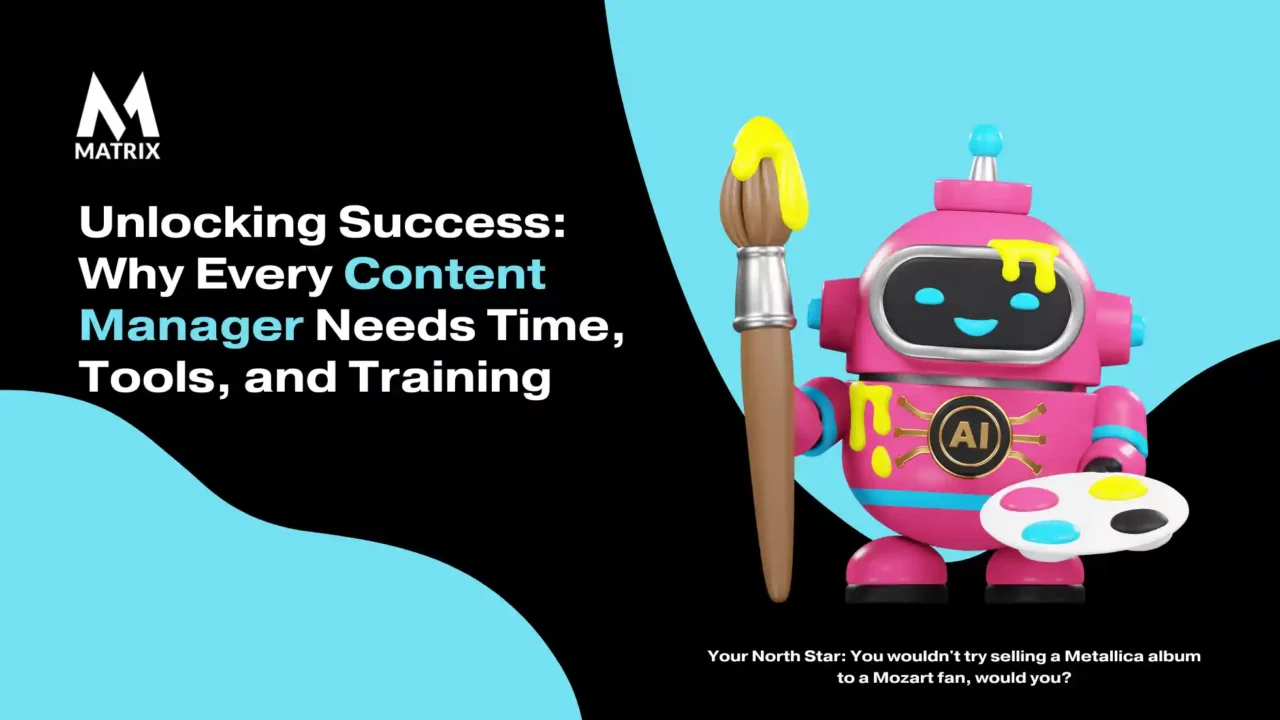Unlocking Success: Why Every Content Manager Needs Time, Tools, and Training
Learn Why Every Content Manager Needs Time, Tools, and Training
Content managers need more time, resources, and skills to develop good content and update old contacts, potentially harming web traffic, lead conversions, and sales.
It has long been insufficient for an organization to survive to be credible in its chosen field of activity. Increasing sophistication in buying and selling in her face has led to questioning her approach to business.
If we simply accepted that if an organization exists, there must necessarily be an economic and profit justification. Various people’s perceptions of companies are summarized in a word image.
But the image embraces the concept far more complex than the definition suggests. The problem is that image has been abused, vilified, and raped until finally, it has become a slightly pejorative term of abuse, like slick.
It is always unfortunate when a useful term and tool have been mishandled. Image sensitivity and image development are important parts of marketing. Indeed, they are marketing themselves.
As a content manager, having the right combination of time, tools, and training is essential to achieving maximum success.
With one or all of these components, your project can quickly become manageable, causing you to stay caught up and gain valuable productivity. In this blog post, content management is undoubtedly important in today’s digital world.
Content managers must hire and foster a competent workforce trained to create, store, and easily access content. Time management should be employed to ensure an efficient work environment and avoid any unnecessary delays.
Moreover, technological tools are a cost-effective way to improve brand data storage security while providing insights into logged activities. Furthermore, training is key to unlocking success as content needs to be proficiently maintained so that there is a flow of information amongst employees who control them.
Businesses should consider these strategies when creating long-term content management goals for organizational success.
Potential customers are now exposed to company details across multiple platforms and have formed expectations regarding the quality of information they receive; companies must deliver consistently high-quality content for customer retention and increased revenue growth.
Therefore, we encourage you to assess your current content management processes and utilize AI-driven synthesized content technologies with deep analytics capabilities where required, as this could be the missing piece in pushing your organization further towards great heights of success!
We’ll discuss the importance of each component and how they influence each other when aiming for successful workflow management. We’ll also examine why access to the right resources can be invaluable in getting the job done on time and within budget. So let’s dive into why every content manager needs these three important elements for their projects to take off!
The size the world and United States of Content generation per year
Analyzing the data provided, it’s estimated that 328.77 million terabytes of data are created each day worldwide. If we multiply this by 365 (days in a year), we get approximately 120 billion terabytes, or 120 zettabytes, of data generated globally per year.
Considering that the US is home to some of the world’s largest technology and internet companies, it’s safe to assume that it contributes a significant portion to global data creation.
Content encompasses everything from social media posts and emails to digital photos and IoT device outputs. However, some broad categories are likely to contribute the most to data creation:
- Social Media: Every minute, users generate massive amounts of data through posts, likes, shares, and comments on various platforms.
- Emails: Over half of the world’s population uses email, contributing significantly to data creation.
- Digital Photos & Videos: With smartphones becoming more prevalent, the amount of digital media being created and shared is immense.
- IoT Devices: These devices constantly collect and send data, contributing to the overall data volume.
- Search Queries: Every search made on search engines like Google contributes to data creation.
- E-commerce Transactions: Online shopping generates substantial data through user behavior, purchases, and reviews.
- Cloud Storage: Files stored and shared through cloud services add to the data volume.
- Streaming Services: The usage data from streaming services like Netflix and Spotify contribute to data creation.
- GPS & Location Data: Data from GPS and other location-based services also add to the overall data volume.
- Business & Industrial Data: This includes data from sectors like manufacturing, healthcare, finance, and more.
It’s important to note that these categories are not exhaustive, and the actual breakdown can vary based on numerous factors.
Understanding the importance of content management for success

In today’s business world, where online presence is everything, understanding the importance of content management is crucial for achieving success.
Effective content management allows businesses to create, organize, and publish content that resonates with their target audience. Studies show that customers tend to engage more with brands that offer valuable content, making them more likely to become loyal customers.
Furthermore, a well-structured content management system improves productivity, saves time, and reduces the risk of obsolete content. By taking content management seriously, businesses can ensure their message is consistent and on-brand, increasing customer satisfaction and success.
Identifying the challenges that content managers face
Being a content manager can come with its fair share of challenges. The responsibilities can be overwhelming, from keeping up with the latest content creation trends to ensuring your content is engaging and relevant.
One major challenge that content managers face is constantly producing fresh and compelling content while maintaining a consistent brand image. Another challenge is staying organized and ensuring that tasks are completed on time.
With so much content produced daily, content designers must stay on top of their game to succeed in this fast-paced industry.
Despite these challenges, content management can also be incredibly rewarding, providing a platform for creativity and the opportunity to connect with audiences worldwide.
Analyzing the role of proper time management in content management success

Proper time management is often the key aspect that separates successful content management from disorganized chaos.
With so many moving parts involved in content creation and distribution, content managers risk delivering subpar work without an efficient time management strategy and missing crucial deadlines and opportunities.
Effective time management can help content managers create a clear plan of action, prioritize tasks, allocate resources, and maintain consistency in their work.
Ensuring every aspect of the content management process stays on schedule, including planning, research, creation, editing, and promotion, is essential. Proper time management leads to greater productivity, increased revenue, and, most importantly, happier customers.
Technology tools’ impact on managing content has revolutionized how we manage content in today’s fast-paced world. From cloud storage solutions to advanced project management systems, we have various tools to help us create, organize, and deliver our content like never before.
The impact of technology tools in this area is undeniable, as they have allowed us to work more efficiently, collaborate with others remotely, and ensure that our content is always up to date.
These tools have also provided greater flexibility, enabling us to work from anywhere. In the end, using technology to manage content has made our lives much easier, and we can only expect more advances in the future.
Examining the necessity of training and development for content managers:
As technology rapidly changes the content creation landscape, it becomes increasingly important for content managers to refine their skills and stay up-to-date. This is where training and development come into play.
By investing in ongoing education and professional development, content managers can expand their knowledge base, learn new techniques, and bolster their ability to manage and distribute content effectively.
Moreover, a well-trained and knowledgeable content manager can help an organization stay ahead of the curve in an ever-evolving digital landscape. Therefore, training and development should be a critical investment in content management’s success and an organization’s overall advancement.
Delineating strategies to ensure successful content management practices
With the abundance of content available on the internet, it’s more important than ever to have a solid content management strategy. But what exactly does that mean?
A successful content management approach involves a range of practices to help you organize, create, store, and distribute content that aligns with your goals and engages your target audience.
From establishing clear guidelines for content creation and curation to implementing effective governance and workflow processes, there are many strategies you can employ to ensure a successful content management practice.
By putting these practices in place, you can maximize the value of your content and provide your audience with the best possible user experience.
What should a budget be for a manufacturing company that generates 20 million in sales?

The average amount of content produced in a year by manufacturing organizations with a $20 million sales revenue.
Firstly, let’s look at the IT and Marketing budgets. Techvera says small companies (less than $50 million in revenue) spend 6.9% of their revenue on IT.
For a company with a $20 million budget, this would translate into approximately $1.38 million spent on IT.
Regarding marketing, Deloitte’s Annual report suggests that companies will allocate roughly 13.6% of their total budget to marketing in 2023. This would account for about $2.72 million from a $20 million budget.
Content creation often falls under the marketing budget. While it’s difficult to pinpoint exactly what percentage of the marketing budget would be allocated toward content creation without specific data.
We estimate roughly from our 20 years of experience developing content. Assuming that around 30% of the marketing budget is dedicated to content creation would amount to $816,000.
The quantity of content can vary greatly depending on the organization’s strategy.
Companies may focus on creating high-quality content, such as whitepapers or extensive blog posts. In contrast, others might prioritize quantity, producing many shorter pieces like social media posts or email newsletters.
Considering an average cost of $500 per piece of content (including research, writing, editing, and distribution), a company with a content creation budget of $816,000 could produce around 1,632 content annually.
The optimal content creation amount would depend on the company’s specific industry, target audience, and content strategy. A manufacturing organization might find more value in producing detailed technical documents and whitepapers, whereas a consumer-facing company might prioritize social media content and blog posts.
These are rough estimates, and figures can vary based on numerous factors.
Pro tips to get started with content generation

Content creation is an integral part of any marketing strategy. However, understanding the costs involved can be challenging. This guide provides a comprehensive breakdown of content creation costs, considering factors like research, strategy, planning, ideation, creation, editing, and post-production.
Hourly Rates for Content Professionals
The first step in estimating content creation costs is understanding the hourly rates for various professionals involved. Here’s a breakdown based on recent data^1^^3^:
- Content Writers: $15 – $40 per hour
- Web Content Specialists: $18 – $34 per hour
- Content Creators: $18 – $55.64 per hour
- Graphic Designers: Up to $50 per hour (particularly on the West Coast)
These prices can vary based on experience, location, and the project’s complexity.
Cost by Media Format
Different media formats require different resources, affecting the cost.
- Blog Posts: These primarily require a content writer. Assuming an average rate of $70 per hour and 6 hours to write a 1,500-word blog post, you can expect to pay between $500.
- Videos: For video content, you’ll need a scriptwriter, videographer, and editor. Videography can cost anywhere from $250 per hour, depending on the complexity of the video. Editing can add additional costs.
- Podcasts: Podcasts require equipment, hosting, and editing. Depending on the quality of the equipment and the editor’s rate, a single episode could cost anywhere from $500.
- E-books and White Papers: These longer-form contents are more time-consuming and thus more costly. Depending on the length and complexity, you could expect to pay anywhere from $2,000+ per piece.
Additional Expenses
Don’t forget to consider additional expenses such as:
- Equipment: This can include cameras, microphones, and lighting for video and podcast production.
- Software: Editing software, graphic design tools, SEO tools, and more.
- Distribution Costs: This could include paid advertising, social media promotion, email marketing software, and more.
Recommendations for Budgeting
Here are some recommendations for budgeting your content creation:
- Prioritize Your Needs: Identify what content will best reach your target audience and prioritize that in your budget.
- Consider Freelancers: Hiring freelancers can often be more cost-effective than hiring full-time staff for content creation.
- Invest in Quality: While it can be tempting to cut corners, remember that high-quality content will yield better results in the long term.
Remember, these are estimated costs, and actual costs can vary. Always request detailed quotes before beginning a project to ensure you budget accurately. But what you really want is a content generation system that can constantly update and create new contact.
Our Happy Clients!
“AIContentPad is an exceptional asset for brand managers, startup teams, entrepreneurs, content writers, editors, and marketers. It empowers us to effectively manage brand messaging, control tone, and effortlessly generate content and manage it with corporate governance. While its rapid-fire approach effectively reduces content production time. This adaptability enhances efficiency and ensures optimal quality and brand management.”
“After finishing my e-learning platform, I want to let everyone know! With the help of AIContentPad, I created action steps for each module without spending hours on the task. AIContentPad made it easy for me to create a complete go-to-market campaign quickly. Thanks to AIContentPad, my favorite AI marketing platform, I can now focus on creating engaging material for my students instead of struggling through tedious tasks. Highly recommended for e-learning companies and educational institutions.”
“AIContentPad is a top-notch branding product. Perfect AI marketing tools for brand management AIContentPad effectively positioned our intricate product lines and cutting-edge technologies to a new customer base. Matrix made it easy. With my AI marketing login, I was up and running in minutes. AIContentPad helped develop a strategic communication plan, messaging, and brand strategy to reach our target audience while sourcing and managing top-notch creative resources with great proficiency.”
General FAQs
How can a lack of content-generating resources harm a brand’s online presence?

A lack of content-generating resources can significantly impact a brand’s online presence by limiting its ability to consistently and frequently publish high-quality content. This, in turn, can lead to decreased search engine rankings, reduced website traffic, and fewer customer interactions, which can negatively affect a brand’s visibility and reputation online.
How do insufficient content-generating resources affect customer engagement?

Insufficient content-generating resources may hinder a brand’s ability to produce engaging, relevant, and valuable content regularly.
This can lead to decreased customer engagement, as there may need to be more fresh and interesting content to keep the audience interested and coming back for more. As a result, customer loyalty and retention rates may also decline.
How does a lack of content-generating resources impact a brand’s competitiveness?

A lack of adequate content-generating resources can make it difficult for a brand to keep up with competitors who can produce and distribute content more frequently and efficiently. This can lead to a diminished market position and overall competitiveness as customers may shift towards those brands that are more active and visible in the content landscape.
How does a lack of content-generating resources influence a brand’s ability to communicate with its audience effectively?

With the necessary content-generating resources, a brand may communicate effectively with its audience. Content is vital for conveying a brand’s messages, values, and offerings to its target market. Without regular, high-quality content, these communications can become sporadic and inconsistent, potentially causing confusion or disinterest among the audience.

